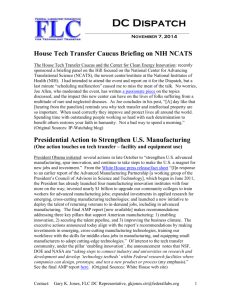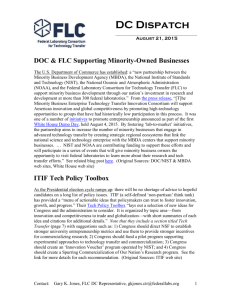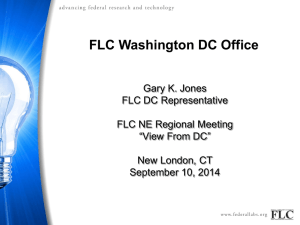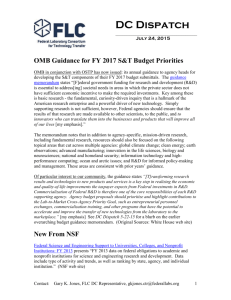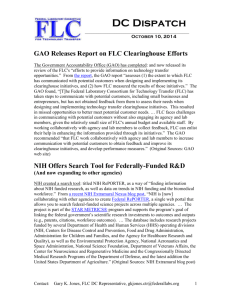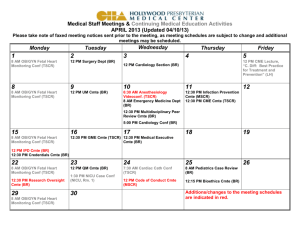May 8 - Federal Laboratory Consortium for Technology Transfer
advertisement
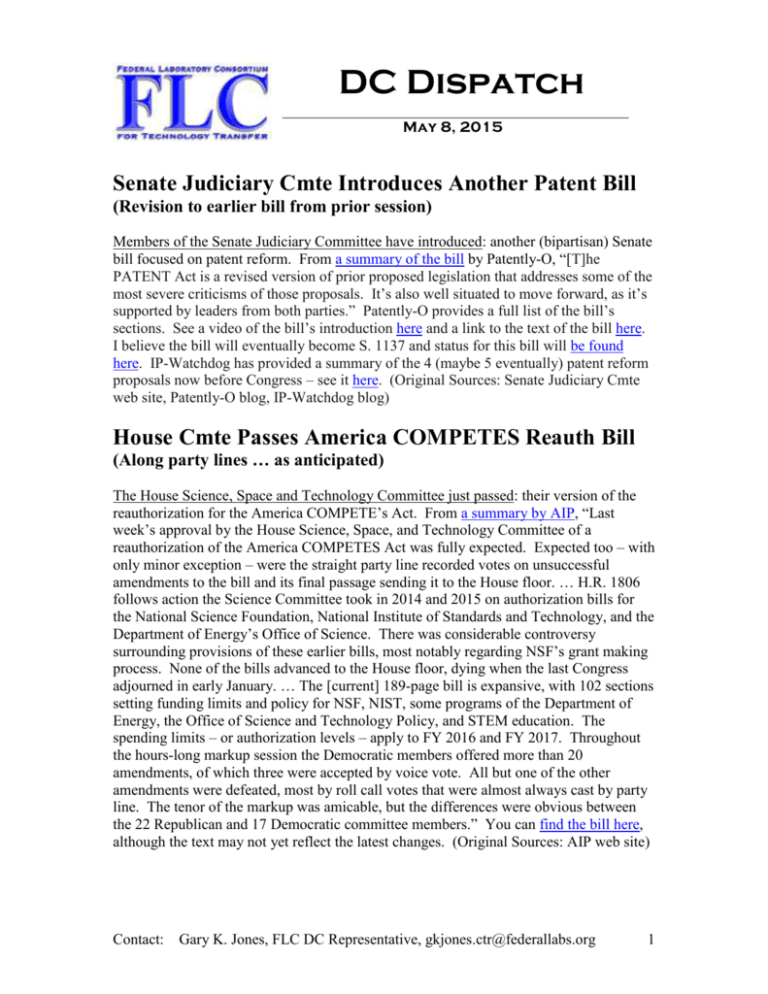
DC Dispatch ______________________________________________ May 8, 2015 Senate Judiciary Cmte Introduces Another Patent Bill (Revision to earlier bill from prior session) Members of the Senate Judiciary Committee have introduced: another (bipartisan) Senate bill focused on patent reform. From a summary of the bill by Patently-O, “[T]he PATENT Act is a revised version of prior proposed legislation that addresses some of the most severe criticisms of those proposals. It’s also well situated to move forward, as it’s supported by leaders from both parties.” Patently-O provides a full list of the bill’s sections. See a video of the bill’s introduction here and a link to the text of the bill here. I believe the bill will eventually become S. 1137 and status for this bill will be found here. IP-Watchdog has provided a summary of the 4 (maybe 5 eventually) patent reform proposals now before Congress – see it here. (Original Sources: Senate Judiciary Cmte web site, Patently-O blog, IP-Watchdog blog) House Cmte Passes America COMPETES Reauth Bill (Along party lines … as anticipated) The House Science, Space and Technology Committee just passed: their version of the reauthorization for the America COMPETE’s Act. From a summary by AIP, “Last week’s approval by the House Science, Space, and Technology Committee of a reauthorization of the America COMPETES Act was fully expected. Expected too – with only minor exception – were the straight party line recorded votes on unsuccessful amendments to the bill and its final passage sending it to the House floor. … H.R. 1806 follows action the Science Committee took in 2014 and 2015 on authorization bills for the National Science Foundation, National Institute of Standards and Technology, and the Department of Energy’s Office of Science. There was considerable controversy surrounding provisions of these earlier bills, most notably regarding NSF’s grant making process. None of the bills advanced to the House floor, dying when the last Congress adjourned in early January. … The [current] 189-page bill is expansive, with 102 sections setting funding limits and policy for NSF, NIST, some programs of the Department of Energy, the Office of Science and Technology Policy, and STEM education. The spending limits – or authorization levels – apply to FY 2016 and FY 2017. Throughout the hours-long markup session the Democratic members offered more than 20 amendments, of which three were accepted by voice vote. All but one of the other amendments were defeated, most by roll call votes that were almost always cast by party line. The tenor of the markup was amicable, but the differences were obvious between the 22 Republican and 17 Democratic committee members.” You can find the bill here, although the text may not yet reflect the latest changes. (Original Sources: AIP web site) Contact: Gary K. Jones, FLC DC Representative, gkjones.ctr@federallabs.org 1 New from GAO Small Business Research Programs: Challenges Remain in Meeting Spending and Reporting Requirements, found “[SBA’s] ability to fully determine compliance with spending requirements for the Small Business Innovation Research (SBIR) and Small Business Technology Transfer (STTR) programs for fiscal year 2013 is limited because most agencies submitted incorrect data. Nevertheless, analyzing agency data submitted to SBA suggests that 9 of the 11 agencies participating in the SBIR program and 4 of the 5 agencies participating in the STTR program complied with spending requirements for fiscal year 2013. Specifically, agencies are required to submit the actual amount obligated for extramural research or research and development (R&D)—which is generally conducted by nonfederal employees outside of federal facilities—and these obligations are the basis for calculating the agencies' spending requirements. However, most agencies submitted budget data instead.” (Original Sources: GAO web site) Speaking of SBA and SBIR/STTR … SBA has recently launched: their new SBIR web site, and a crowdsource competition to develop the new logo. See the press release here. (Original Sources: SBA web site) New from NSF Full-Time Graduate Enrollment in Science and Engineering Rose in 2013, Fueled by a Large Increase in Foreign Graduate Enrollment notes “[T]he number of full-time graduate students enrolled in science and engineering (S&E) programs rose by 2.4% in 2013 after remaining relatively flat for the past 2 years. This increase was largely due to a 7.9% increase in full-time enrollment of foreign students on temporary visas. In 2013, full-time S&E foreign graduate enrollment reached an all-time high of 168,297 students, and they now represent 39.6% of all full-time S&E graduate students, up from 35.9% in 2008. In contrast, full-time S&E graduate enrollment of U.S. citizens and permanent residents declined for the third year in a row.” (Original Sources: NSF web site) Majority of Federally Funded R&D Centers Report Declines in R&D Spending in FY 2013 notes “[T]he nation's 40 federally funded R&D centers (FFRDCs) spent $16.9 billion on research and development in FY 2013…. The majority of the FFRDCs (24 centers) reported declines from FY 2012, and 17 reported two straight years of declines between FY 2011 and FY 2013. FFRDCs are privately operated R&D organizations that are exclusively or substantially financed by the federal government. Federal funding has consistently accounted for over 96% of FFRDC's total R&D expenditures since 200, but these federally funded expenditures have been declining since a high of $18 billion reported in FY 2010. This high corresponded to the peak of award spending from the one-time American Recovery and Reinvestment Act of 2009 (ARRA), which topped $1 billion in FY 2010. By FY 2013, most of the funding from ARRA had been spent, leaving only $170 million in ARRA-funded expenditures, 1% of the federally funded total.” See also the FFRDC Research and Development Survey and the latest Master List of FFRDCs. (Original Sources: NSF web site) Contact: Gary K. Jones, FLC DC Representative, gkjones.ctr@federallabs.org 2 MIT Report on Potential U.S. Innovation Deficit (From a declining investment in basic research) THE FUTURE POSTPONED: Why Declining Investment in Basic Research Threatens a U.S. Innovation Deficit “provides a number of tangible examples of underexploited areas of science and likely consequences in the form of an innovation deficit, including: 1) opportunities with high potential for big payoffs in health, energy, and hightech industries; 2) fields where we risk falling behind in critical strategic capabilities such as supercomputing, secure information systems, and national defense technologies; 3) areas where national prestige is at stake, such as space exploration, or where a lack of specialized U.S research facilities is driving key scientific talent to work overseas.” They note the benefits of investing in basic research in helping shape and maintain U.S. economic power, but also point to how basic research is often misunderstood due to its lack of immediate payoff. The report provides a sector-by-sector analysis of the potential benefits of expanding basic research in these important scientific areas. (Original Sources: MIT web site) NAS 2015 Award Recipients Announced (NIH NCI represented) The National Academy of Sciences has identified: it 2015 award winners. See the list here. I notice at least one federal lab member (from the National Cancer Institute). Congrats to all! (Original Sources: NAS web site) Just for Fun Students win competition: by building a car that gets …. 3,421 MPG! As reported in Fast Co Exists, “[E]very year, the Shell Eco-Marathon Americas [competition challenges] high school and university students to build insanely fuel efficient vehicles. The winners often achieve over 100 times the miles per gallon of a typical car. It's a little burst of hope for the future of transportation—if these kids can build these cars, imagine what will happen when they're actually part of the auto industry. This year's big winner was the University of Toronto, which got 3,421 miles per gallon for their gasolinepowered vehicle on a track in Detroit. (Original Sources: Fast Co Exists web site) ---------------------------------------------------------------------------------------------- Note: The DC Dispatch is a periodic update of selected items of interest to the FLC and technology transfer community -- i.e., current legislation, trends, reports, policy and other developments potentially affecting technology transfer or related activities -- designed to keep the community informed of relevant issues on a timely basis. Information is gleaned directly from a variety of sources (newsletters, email alerts, web sites, direct participation at events from the FLC DC Representative’s office, etc.) -- with original sources, contacts and links provided. Contact: Gary K. Jones, FLC DC Representative, gkjones.ctr@federallabs.org 3
